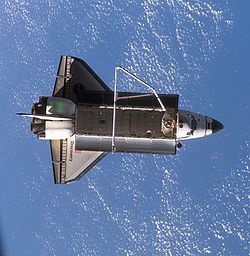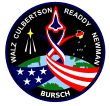Space Shuttle Discovery
The space shuttle Discovery (NASA designation: OV-103) is one of three spacecraft to remain in NASA's space shuttle fleet, along with Atlantis and Endeavour. Discovery was the oldest orbiter still in service and performed a variety of satellite assembly and research missions, as well as International Space Station (ISS) construction missions.
The ship's name comes from the exploration ship HMS Discovery, which accompanied James Cook's HMS Resolution on her third and final voyage. Other vessels share the same name, such as Henry Hudson's Discovery, which between 1610 and 1611 sought the Northwest Passage; and Scott and Shackleton's RRS Discovery which was used on their Antarctic voyages from 1901-1904. In addition, the shuttle shares its name with the fictional ship Discovery One from the movie 2001: A Space Odyssey.
Discovery was the shuttle that launched the Hubble Space Telescope. The second and third Hubble servicing missions were also carried out by Discovery. It also launched the Ulysses probe and three TDRS satellites. Discovery has been chosen twice as the orbiter to return to space, the first in 1988 as a return after the Challenger spacecraft accident in 1986 and, later, in a double return in July 2005 and July 2006 after the spacecraft accident. Shuttle Columbia of 2003. The shuttle also carried Mercury Program astronaut John Glenn, who was 77 years old at the time, making him the oldest person in space.
Flights
The shuttle Discovery completed a total of 39 missions. It is the shuttle that has carried out the most missions among all space shuttles.
Table of missions
| Date | Name | Notes |
|---|---|---|
| 30 August 1984 | STS-41-D | Discovery's first mission. Launch of two communication satellites, one of them LEASAT F2. |
| 8 November 1984 | STS-51-A | Two communication satellites, including LEASAT F1, were launched and captured. |
| 24 January 1985 | STS-51-C | Launch of the Magnun satellite of electronic intelligence of the United States Department of Defense. |
| 12 April 1985 | STS-51-D | Launch of two communication satellites, one of them LEASAT F3. |
| 17 June 1985 | STS-51-G | Launch of two communication satellites. Sultan Salman al-Saud becomes the first Saudi in space. The first Mexican Morelos I satellite is also launched. |
| 27 August 1985 | STS-51-I | Launch of two communication satellites, one of them LEASAT F4. Recovery of LEASAT F3. |
| 29 September 1988 | STS-26 | Back to space after the Challenger ferry crash. Launch of TDRS-3. |
| 13 March 1989 | STS-29 | Launch of TDRS-4. |
| 22 November 1989 | STS-33 | Launch of the satellite of the Department of Defense Magnum. |
| 24 April 1990 | STS-31 | Launch of Hubble Space Telescope (HST). |
| 6 October 1990 | STS-41 | Launch of the Ulysses probe. |
| 28 April 1991 | STS-39 | Launch of the Department of Defense AFP675 satellite. |
| 12 September 1991 | STS-48 | Launch of the UARS satellite. |
| 22 January 1992 | STS-42 | International Microgravity Laboratory-1 (IML-1). |
| 2 December 1992 | STS-53 | Satellite orbit and other Department of Defense materials. |
| 8 April 1993 | STS-56 | Atmospheric Laboratory orbit (ATLAS-2). |
| 12 September 1993 | STS-51 | Launch of Advanced Communications Technology Satellite (ACTS). |
| 3 February 1994 | STS-60 | Launch of the Wake Shield Facility experiment and the Spacehab module. |
| 9 September 1994 | STS-64 | Launch of the LIDAR In-Space Technology Experiment (LITE). |
| 3 February 1995 | STS-63 | Meeting with Mir Space Station. |
| 13 July 1995 | STS-70 | Launch of TDRS-7. |
| 11 February 1997 | STS-82 | Hubble Telescope Service Tasks (HSM-2). |
| 7 August 1997 | STS-85 | Launch of the research satellite CRISTA-SPAS-2. |
| 2 June 1998 | STS-91 | Last coupling mission between the shuttle and the Mir space station. |
| 29 October 1998 | STS-95 | Second flight from John Glenn. Pedro Duque becomes the first Spanish in space. |
| 27 May 1999 | STS-96 | Provision of the International Space Station. |
| 19 December 1999 | STS-103 | Service Tasks to the Hubble Telescope (HSM-3). |
| 11 October 2000 | STS-92 | International Space Station mounting mission (ISS), transporting the Z1 structure. Mission number 100 of the space shuttle program. |
| 8 March 2001 | STS-102 | ISS crew rotation flight (Expedition 1 and Expedition 2). |
| 10 August 2001 | STS-105 | ISS crew rotation flight (Expedition 2 and Expedition 3) and delivery of supplies. |
| 26 July 2005 | STS-114 | Back to space after the Columbia shuttle accident. Delivery of supplies to ISS and new security procedures. |
| 4 July 2006 | STS-121 | Delivery of supplies and crew to ISS. |
| 9 December 2006 | STS-116 | Rotation of the ISS crew and assembly of the P5 segment. |
| 20 October 2007 | STS-120 | ISS Ensemblage: Harmony Module, rotation of the crew. |
| 31 May 2008 | STS-124 | ISS Sketch: JEM - Japanese "Kibo" & JEM RMS Module. |
| 15 March 2009 | STS-119 | Continuing the construction of the ISS, installing new solar panels. |
| 28 August 2009 | STS-128 | Take the Leonardo module with six tons of supplies and scientific equipment to the space station. They travel for the first time two American astronauts of Mexican descent: José M. Hernández and John D. Olivas. |
| 5 April 2010 | STS-131 | The main useful charge was the multipurpose logistics module (MPLM) Leonardo. The mission also attached a spare ammonia tank to assemble it outside the station and return a European experiment that was outside the Columbus module. |
| 24 February 2011 | STS-133 | The mission, whose launch went to the 4:50 p. m. EST on February 24, carried the Multipurpose Logistic Module (MPLM) Leonardo and the ELC-4 to the ISS. This was his last flight, as he did not re-schedule within the Space Shuttle Program. |
Tribute and Mission Badges
| NASA Tribute by Discovery Space Shuttle | |||||||
|---|---|---|---|---|---|---|---|
| Mission badge for Discovery mission flights | |||||||
STS-41-D | STS-51-A | STS-51-C | STS-51-D | STS-51-G | STS-51-I | STS-26 | STS-29 |
STS-33 | STS-31 | STS-41 | STS-39 | STS-48 | STS-42 | STS-53 | STS-56 |
STS-51 | STS-60 | STS-64 | STS-63 | STS-70 | STS-82 | STS-85 | STS-91 |
STS-95 | STS-96 | STS-103 | STS-92 | STS-102 | STS-105 | STS-114 | STS-121 |
STS-116 | STS-120 | STS-124 | STS-119 | STS-128 | STS-131 | STS-133 | |
End of the space race

Like the three remaining shuttles (Endeavour, Atlantis and this one), it is out of service after the shuttles were canceled in 2011. Its last flight was the STS-133 mission, from February 24 to March 9, 2011, which was successful, aimed at installing a new storage module and a humanoid robot. This module, which was permanently connected to the station, offers an additional volume of storage under pressure.
"This legend was in space for 365 days," they reported from the NASA Control Center in Houston (South Texas), adding that, with its 39 missions, Discovery traveled almost 149 million miles (241 million kilometers).
The craft is now in the Steven F. Udvar-Hazy Center, an annex of the Smithsonian's National Air and Space Museum in Washington, D.C.
Contenido relacionado
Particle accelerator
Satellites of mars
Wind instrument








































